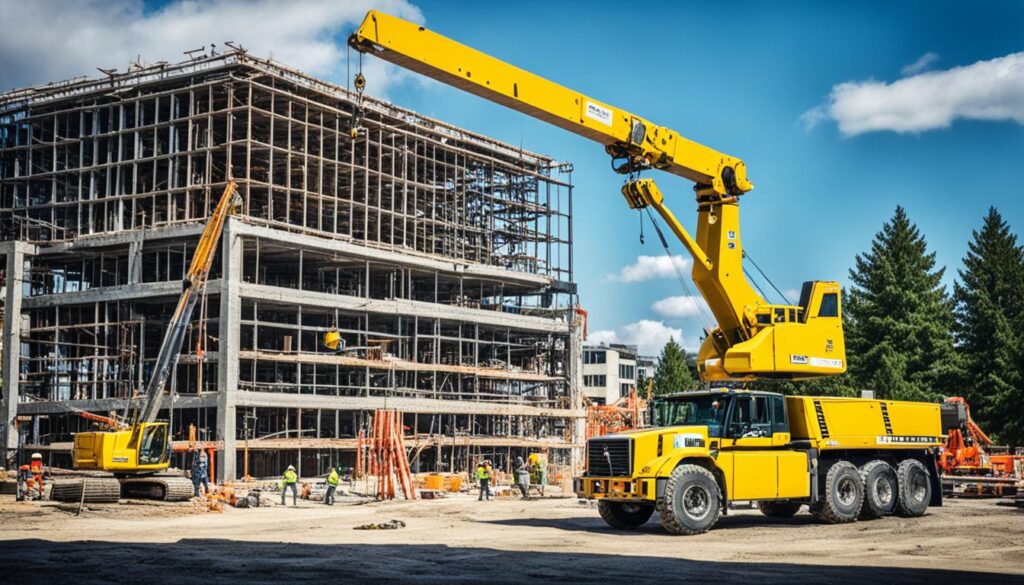In the world of construction and engineering, where large, powerful machinery is the backbone of progress, the importance of counterweights cannot be overstated. These essential components play a pivotal role in maintaining the stability, balance, and safety of heavy equipment used in building projects, from towering cranes to massive excavators. By offsetting the weight of various machine parts and the loads they carry, counterweights help prevent tipping, improve lifting capacity, and distribute forces evenly, ensuring the smooth and secure operation of these vital tools of the trade.
Key Takeaways
- Counterweights are crucial for the stability and balance of heavy construction equipment.
- They help prevent tipping, improve lifting capacity, and distribute forces evenly across machinery.
- Precise design and placement of counterweights are essential for the safe and efficient operation of construction equipment.
- Counterweights play a vital role in ensuring the successful completion of building projects.
- Understanding the importance of counterweights is crucial for construction engineers and site managers.
Understanding Heavy Equipment and Counterweights
Heavy equipment is a broad category that encompasses a wide range of large, powerful vehicles and machines used in various construction, engineering, and industrial applications. These include bulldozers, mobile cranes, excavators, and similar equipment designed to handle demanding tasks such as cutting, pushing, digging, and lifting heavy loads.
What Is Heavy Equipment?
The key components that define heavy equipment are the frame, which serves as the skeletal structure, and the counterweight, which is attached to the rear of the machine to improve stability and balance. These critical elements are engineered with precision to ensure the equipment can operate safely and effectively, even under the most challenging conditions.
Types of Heavy Equipment and Their Structures
There is a diverse array of heavy equipment types, each with its own unique design and structure. For instance, bulldozers have a tractor-like body with a blade attachment at the front and a ripper at the back, along with either wheeled or crawler-type undercarriages. Mobile cranes, on the other hand, feature a self-propelled body with a long, articulated boom for lifting and moving loads. Excavators consist of an upper swing body, a lower travel body, and a work device unit with a boom, arm, and bucket.
Heavy Equipment Parts and Materials
The key parts of heavy equipment, such as frames, counterweights, and connectors like kingpins and couplers, are often made from high-strength materials like rolled steel and cast steel. These components are subjected to heavy loads, impacts, and stresses during operation, so they require careful design and manufacturing to ensure their structural integrity and dimensional accuracy. Processes like gas-shielded arc welding and the use of low-PCM steels are employed to achieve the necessary performance and safety standards.
“The selection of materials and manufacturing methods is crucial for the performance and safety of heavy equipment.”
The Importance of Dimensional Measurement for Counterweights
Precise dimensional measurement of heavy equipment parts, particularly counterweights and frames, is crucial for ensuring the safe and reliable operation of these machines. Counterweights, which can weigh up to 74 tons in large cranes, must be accurately measured and manufactured to balance the dynamic forces experienced during operation. Similarly, the dimensional accuracy of frames, such as the revolving frame, track frame, and swing frame, directly impacts the stability and performance of the equipment.
Necessity of Dimensional Measurement of Heavy Equipment Parts
Measurement of crucial components like the kingpin and coupler is also important, as these connectors play a vital role in the machine’s overall functionality and load-bearing capacity. The dimensional measurement of heavy equipment parts involves carefully inspecting and verifying the critical dimensions at various stages of the manufacturing process, from casting and machining to final assembly.
Dimensional Measurement Points for Counterweights and Frames
For counterweights, this includes measuring the dimensions of individual cast parts, the machining allowance before additional processing, and the final dimensions and flatness after machining. For frames, the dimensional accuracy of the revolving frame, track frame, and swing frame, as well as the positions of connectors like the kingpin and coupler, must be meticulously measured to ensure proper assembly and performance. These precise measurements help identify and address any issues related to strain, rotation accuracy, and travel performance, ultimately enhancing the safety and reliability of the heavy equipment.

“Dimensional measurement is the cornerstone of heavy equipment safety and performance.”
Construction Counterweight: Ensuring Stability and Safety
Counterweights are the unsung heroes of the heavy machinery world, playing a crucial role in maintaining the stability and safety of construction equipment. These ingenious devices counterbalance the dynamic forces and uneven weight distribution caused by various machine components and attachments, ensuring the equipment remains steady and secure during operation.
Functions of Counterweights in Heavy Machinery
By offsetting the weight of the load, counterweights enhance a machine’s lifting capacity, allowing it to handle heavier objects safely. They also help balance the weight distribution across the machine, improving its maneuverability and reducing stress on the structural components, which extends the equipment’s lifespan and reduces maintenance requirements.
Types of Counterweights and Their Applications
- Gravity counterweights use the force of gravity to balance an object, such as in sash windows.
- Counterbalance springs exert an opposing force to help lift or lower heavy objects, as seen in garage doors and forklifts.
- Hydraulic and pneumatic systems can create dynamic counterweights with adjustable weight, making them suitable for construction equipment like cranes.
- Flywheels, magnetic counterweights, and liquid or gas-filled containers are also used as counterweights in specialized applications.
- Adjustable counterweights, which can be modified to accommodate changing loads, are found in gym equipment and other precision devices.
- Ballast counterweights, consisting of heavy materials like water or sand, provide stability for ships and aircraft.
Designing and Calculating Counterweights for Optimal Performance
Designing effective counterweights for heavy machinery requires careful consideration of various factors. Engineers must calculate the required weight based on the force needed to balance the load or control the motion, ensuring the counterweight’s mass is sufficient. The selection of high-density materials, such as concrete, steel, lead, or cast iron, is crucial. Positioning the counterweight’s center of gravity accurately to align with the load’s center of gravity is essential for maintaining effective balance. Secure attachment of the counterweight, considering environmental factors like temperature, humidity, and corrosion, is also important. Building and testing a prototype can help identify any unforeseen issues and validate the counterweight’s design before full-scale production or installation.
“Counterweights are the unsung heroes of the heavy machinery world, playing a crucial role in maintaining the stability and safety of construction equipment.”
Conclusion
Counterweights are essential components in construction and engineering equipment, providing the stability, balance, and safety required for these powerful machines to operate effectively. By offsetting the weight of various parts and loads, counterweights help prevent tipping, improve lifting capacity, and distribute forces evenly. The precise design, manufacturing, and dimensional measurement of counterweights and related components, such as frames, are crucial for ensuring the reliable and safe performance of heavy equipment.
As construction and infrastructure development continue to advance, the role of counterweights in maintaining the stability and efficiency of these critical machines will remain paramount. By understanding the importance of heavy equipment and counterweights, we can ensure that our construction projects are executed with the highest levels of safety and efficiency, contributing to the progress and development of our communities.
In conclusion, the insights and knowledge gained from this article will empower professionals in the construction and engineering industries to make informed decisions regarding the selection, design, and deployment of counterweights, ultimately leading to safer, more reliable, and more productive heavy equipment operations.
FAQ
What is the role of counterweights in heavy machinery used in construction and engineering?
Counterweights play a vital role in maintaining the stability, balance, and safety of heavy machinery. By offsetting the weight of various equipment parts and the loads they carry, counterweights help prevent tipping, improve lifting capacity, and distribute forces evenly. Their precise design and placement are essential for the smooth and secure operation of construction machinery.
What are the key components of heavy equipment?
The key components of heavy equipment include the frame, which serves as the skeletal structure, and the counterweight, which is attached to the rear of the machine to improve stability and balance. Heavy equipment is characterized by its size, strength, and ability to perform tasks such as cutting, pushing, digging, and lifting heavy loads.
What types of heavy equipment are commonly used in construction and engineering?
Common types of heavy equipment include bulldozers, mobile cranes, and excavators. These diverse structures and components are carefully engineered to perform specific tasks efficiently and safely.
What materials are used for the critical parts of heavy equipment?
The key parts of heavy equipment, such as frames, counterweights, and connectors like kingpins and couplers, are often made from high-strength materials like rolled steel and cast steel. These parts require careful design and manufacturing to withstand the heavy loads, impacts, and stresses they encounter during operation.
Why is precise dimensional measurement of heavy equipment parts important?
Precise dimensional measurement of heavy equipment parts, particularly counterweights and frames, is essential for ensuring the safe and reliable operation of these machines. Counterweights must be accurately measured and manufactured to balance the dynamic forces experienced during operation, while the dimensional accuracy of frames directly impacts the stability and performance of the equipment.
How do counterweights contribute to the stability and performance of heavy machinery?
Counterweights play a critical role in ensuring the stability, load-bearing capacity, and overall performance of heavy machinery. By counterbalancing the dynamic forces and uneven weight distribution caused by various machine components and attachments, counterweights help maintain the equipment’s stability during operation, prevent tipping or toppling, and enhance the machine’s lifting capacity.
What are the different types of counterweights used in heavy machinery?
Counterweights come in a variety of forms, including traditional gravity counterweights, counterbalance springs, hydraulic and pneumatic systems, flywheels, magnetic counterweights, and liquid or gas-filled containers. The selection of the appropriate counterweight type depends on the specific application and requirements of the heavy machinery.
What factors are considered when designing effective counterweights for heavy machinery?
Designing effective counterweights requires careful consideration of factors such as the required weight based on the force needed to balance the load, the selection of high-density materials, the accurate positioning of the counterweight’s center of gravity, secure attachment, and accounting for environmental factors. Building and testing a prototype can help validate the counterweight’s design before full-scale production or installation.


